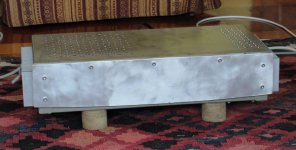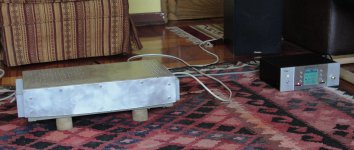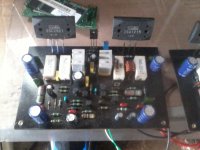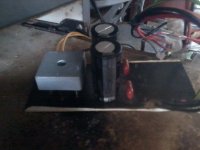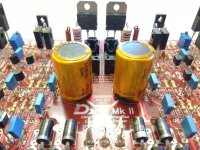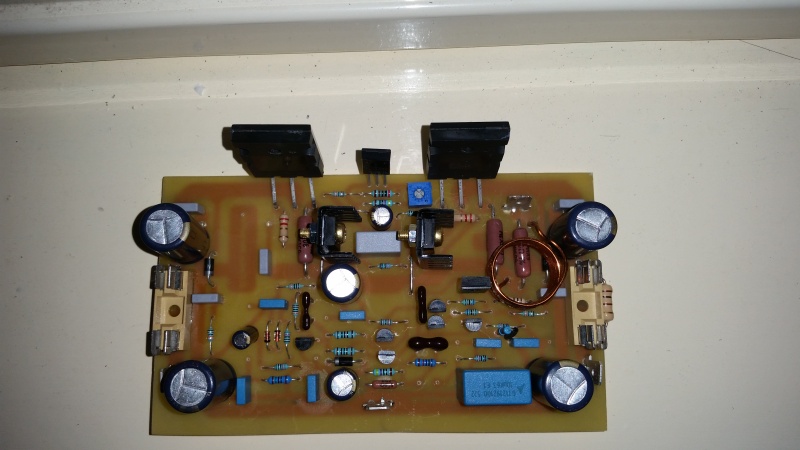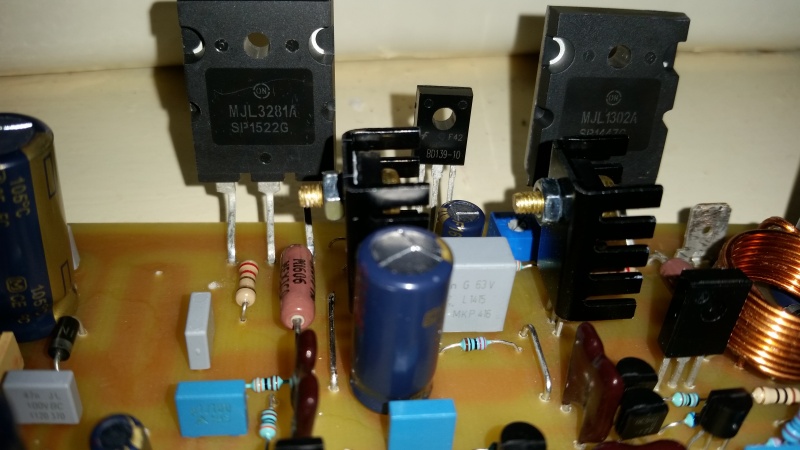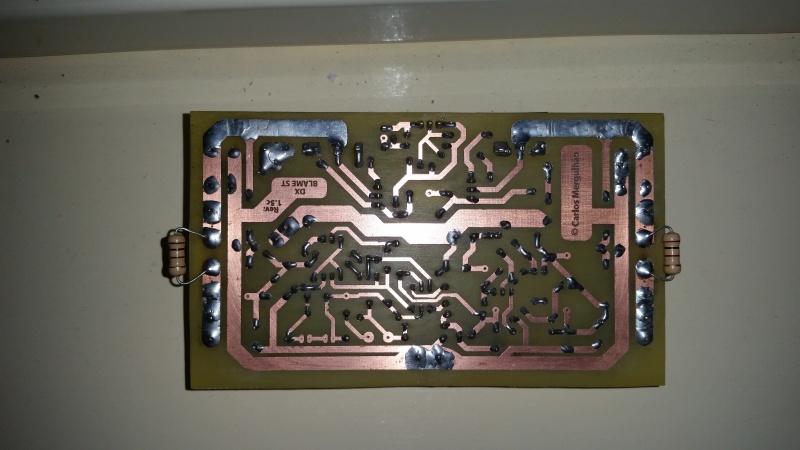Williamdomingues...check your construction several times till you find errors
For sure this is not a nomal behavior and i cannot know what kind of mistake was made....there are so many options of mistakes that will be crazy to try to list them.
Check till you find.... check resistors, diodes and transistors related polarity, value and remove them, one by one, out from the pcboard to be tested.
Check the pcboard with the schematic..check each copper track and trace the checked lines in red or blue or other colour into your printed schematic
Check for interrupted copper lines and check for short circuits.
Strange behavior like off set, or big voltage into the output, no modification in bias current when you turn the trimpot, over heat in components or parts damaged show us the circuit is wrong related construction.
If you find the mistake, since parts are not damaged, then the amplifier will work perfectly...if not working you do not pray to god....work till you find the mistake.
regards,
Carlos
For sure this is not a nomal behavior and i cannot know what kind of mistake was made....there are so many options of mistakes that will be crazy to try to list them.
Check till you find.... check resistors, diodes and transistors related polarity, value and remove them, one by one, out from the pcboard to be tested.
Check the pcboard with the schematic..check each copper track and trace the checked lines in red or blue or other colour into your printed schematic
Check for interrupted copper lines and check for short circuits.
Strange behavior like off set, or big voltage into the output, no modification in bias current when you turn the trimpot, over heat in components or parts damaged show us the circuit is wrong related construction.
If you find the mistake, since parts are not damaged, then the amplifier will work perfectly...if not working you do not pray to god....work till you find the mistake.
regards,
Carlos
Back to back is fine Max, but if found the NFB transistor base to emitter
junction rectify and there you gonna have pure DC...so, the polarity will remain the same unless the NFB transistor is shorted...there, the current is small, you see that you have a series resistor to the speaker post.... the capacitor makes stable voltage there.
What you have is the unbalance of gain when DC arrives at the NFB transistor base due to the output voltage swing...and there gonna be positive....or pulsating positive pulses.... you can modify if you want...but real live tests show nothing in advantage, reason why i have removed the back to back capacitors present in earlier designs.
The capacitor also is over rated...real stuff is the voltage there is 670 milivolts or aprox this voltage due to the zener effect you have from the transistor base to emitter junction....the output can have 60 volts of swing PEP but there you will have a few millivots only..at the capacitor extremes the voltage is very small..why we suggest 50 or 100 volts units there?... because if you have short in the output transistor, due to damage, then you gonna have rail voltage appearing there.... and people can do mistakes and short the output..to avoid this capacitor explosion we use 50 to 100 volts units there..but in the reality a 6 volts will work fine there.
I found current of 70 to 90 mA as the best possible current...it appears only in very low volume as this removes distortion at very low volumes of sound because keep transistor in conduction...not having switching noises due to the bias current, the amplifier will sound better in pianissimo.
We use some traditional stuff dear Max..because people has beliefs...faith.... if you put 6 volts capacitor there they think you have not knowledge..in the reality the problem of knowledge is not really mine..but to avoid people shocked i use some traditional stuff, even knowing is full sheep
regards,
Carlos
junction rectify and there you gonna have pure DC...so, the polarity will remain the same unless the NFB transistor is shorted...there, the current is small, you see that you have a series resistor to the speaker post.... the capacitor makes stable voltage there.
What you have is the unbalance of gain when DC arrives at the NFB transistor base due to the output voltage swing...and there gonna be positive....or pulsating positive pulses.... you can modify if you want...but real live tests show nothing in advantage, reason why i have removed the back to back capacitors present in earlier designs.
The capacitor also is over rated...real stuff is the voltage there is 670 milivolts or aprox this voltage due to the zener effect you have from the transistor base to emitter junction....the output can have 60 volts of swing PEP but there you will have a few millivots only..at the capacitor extremes the voltage is very small..why we suggest 50 or 100 volts units there?... because if you have short in the output transistor, due to damage, then you gonna have rail voltage appearing there.... and people can do mistakes and short the output..to avoid this capacitor explosion we use 50 to 100 volts units there..but in the reality a 6 volts will work fine there.
I found current of 70 to 90 mA as the best possible current...it appears only in very low volume as this removes distortion at very low volumes of sound because keep transistor in conduction...not having switching noises due to the bias current, the amplifier will sound better in pianissimo.
We use some traditional stuff dear Max..because people has beliefs...faith.... if you put 6 volts capacitor there they think you have not knowledge..in the reality the problem of knowledge is not really mine..but to avoid people shocked i use some traditional stuff, even knowing is full sheep
regards,
Carlos
Dear Carlos,
Finally, the Blame ST is on its new DIY case.
The fins are a little small but that's all I had.
Sounding very good with deep and full bass. Never a complaint there, even with cheap SMPS (modded). Very especial sound, naturally detailed and layered.
Thanks again and enjoy.
M.
Finally, the Blame ST is on its new DIY case.
The fins are a little small but that's all I had.
Sounding very good with deep and full bass. Never a complaint there, even with cheap SMPS (modded). Very especial sound, naturally detailed and layered.
Thanks again and enjoy.
M.
Attachments
Dx Blame ST Ultra Best Stereo Sound Build Ever...
Attachments
Install 1K in series with the colector
I normal use it does not burn because I HAVE MY OWN AMPLIFIER WORKING DAILY TOGETHER MY COMPUTER AND NEVER BURNED.
But, some monster users inject 4 volts RMS from a preamplifier in the input, when there you have to inject maximum of 500 milivolts RMS...and there"s the result.....the guy want to listen distortion should go to listen and Hidraulical hammer instead to build high end amplifiers....$*&¨#&$#)_+
Mad not against you...mad with people that say it burns....in normal civilized way it works fine...mine one....long years working proves that.
Those guys that loves distortion and high power should buy Brazilian amplifiers...we have 8 kilowatts units and very cheap if you convert to US Dollars..and they can put out 8 kilowatts into 2 ohms, 5 minutos full power at 1 kilohertz, sinusoidal in the threshold of clippping..... then....some power manicas, instead to by this kind of stuf build high end material and twist volume knob crancking all the way up and ajust equalizer full bass and full volume ....well.....madness!
https://www.youtube.com/watch?v=M7civWDUImg
Wanna know uncle charlie?.... listen to Trump...i am not different.
regards,
Carlos
I normal use it does not burn because I HAVE MY OWN AMPLIFIER WORKING DAILY TOGETHER MY COMPUTER AND NEVER BURNED.
But, some monster users inject 4 volts RMS from a preamplifier in the input, when there you have to inject maximum of 500 milivolts RMS...and there"s the result.....the guy want to listen distortion should go to listen and Hidraulical hammer instead to build high end amplifiers....$*&¨#&$#)_+
Mad not against you...mad with people that say it burns....in normal civilized way it works fine...mine one....long years working proves that.
Those guys that loves distortion and high power should buy Brazilian amplifiers...we have 8 kilowatts units and very cheap if you convert to US Dollars..and they can put out 8 kilowatts into 2 ohms, 5 minutos full power at 1 kilohertz, sinusoidal in the threshold of clippping..... then....some power manicas, instead to by this kind of stuf build high end material and twist volume knob crancking all the way up and ajust equalizer full bass and full volume ....well.....madness!
https://www.youtube.com/watch?v=M7civWDUImg
Wanna know uncle charlie?.... listen to Trump...i am not different.
regards,
Carlos
Attachments
Last edited:
Thank you Niss_man
I do not remember, but you can adjust sensistivity tweaking a resistor that is connected to the second differential transistor base..... it goes to ground through an electrolitic capacitor.... increase this resistor a couple of fold....try a bigger one...let's say..... 5K or even bigger and then you will be able to inject 6 volts into your Blame.
I am sorry, too much busy to stay here, i will ask people that is following this forum daily to help you.
I am building amplifiers to brazilians. my time is very small now a days...and my work in Brazil is paid.....earning money, and this is a need now a days.
regards,
Carlos
I do not remember, but you can adjust sensistivity tweaking a resistor that is connected to the second differential transistor base..... it goes to ground through an electrolitic capacitor.... increase this resistor a couple of fold....try a bigger one...let's say..... 5K or even bigger and then you will be able to inject 6 volts into your Blame.
I am sorry, too much busy to stay here, i will ask people that is following this forum daily to help you.
I am building amplifiers to brazilians. my time is very small now a days...and my work in Brazil is paid.....earning money, and this is a need now a days.
regards,
Carlos
I send you some 2N5551 if you want me tohey guys, i fixed that issued adding the 1k resistor between the C of q6 and ground.
it is also recommended to replace th bc546 with 2N5551 but I can't find it.
Do you think bf493 is also good ?
hey my friends, here's the first channel of my dx blame.
Hope it will work at first attempt and no blow anymore.
regards
Congratulations and good luck!
For those interested, I've been doing some experiments with the Blame's PS.
At first, I ran the Blame with a conventional linear PS that I use for experimentation and yet it sounded very good, as is supposed to sound.
I did not have any suitable box that could accomodate the amps and the big linear PS that I wanted, so I choose instead an inexpensive 500W SMPS. SMPS as you know have many very convenient traits, like slow turn-on, small size, efficiency, relativelly low cost, auxiliary PS voltages...
The Blame with the inexpensive stock SMPS sounded very clean but lacked weight and "roundness" of sounds (due to lack of experience I bought a regulated SMPS which I think may be part of the problem), compared to basic linear PS, which usually means less mid-bass. I paralelled some Wima 1uF red caps to the outputs caps and I think it improved a lot the sound, being more "refined" but still lacking in the mid-bass and bass extension. I decided to use my usual weapon and added 18mF of Rubycon ZL caps per PS rail, to the existing 6.8mF of capacitance. I added also a power Thermistor in series with the AC input line to avoid triggering inrush current protection mode. It worked nicelly, with >4 seconds delay in start-up.
Well, intial impression is very good, better than with basic linear PS, better than ever. A truly great amp to enjoy classic rock and jazz music as percusion is very engaging and instrumental timbres are very naturally rendered.
I will continue my experiments with more advanced SMPS as I suspect them also...
Thank you uncle Charly.

Cheers,
M.
Congratulations and good luck!
For those interested, I've been doing some experiments with the Blame's PS.
At first, I ran the Blame with a conventional linear PS that I use for experimentation and yet it sounded very good, as is supposed to sound.
I did not have any suitable box that could accomodate the amps and the big linear PS that I wanted, so I choose instead an inexpensive 500W SMPS. SMPS as you know have many very convenient traits, like slow turn-on, small size, efficiency, relativelly low cost, auxiliary PS voltages...
The Blame with the inexpensive stock SMPS sounded very clean but lacked weight and "roundness" of sounds (due to lack of experience I bought a regulated SMPS which I think may be part of the problem), compared to basic linear PS, which usually means less mid-bass. I paralelled some Wima 1uF red caps to the outputs caps and I think it improved a lot the sound, being more "refined" but still lacking in the mid-bass and bass extension. I decided to use my usual weapon and added 18mF of Rubycon ZL caps per PS rail, to the existing 6.8mF of capacitance. I added also a power Thermistor in series with the AC input line to avoid triggering inrush current protection mode. It worked nicelly, with >4 seconds delay in start-up.
Well, intial impression is very good, better than with basic linear PS, better than ever. A truly great amp to enjoy classic rock and jazz music as percusion is very engaging and instrumental timbres are very naturally rendered.
I will continue my experiments with more advanced SMPS as I suspect them also...
Thank you uncle Charly.
Cheers,
M.
I also tried a 450w SMPS 52v rail supply with my VHex amp vs the 300va toroidal linear supply and got excellent results. Bass is very good and ripple with a CRC using four 4700uF caps is excellent. No hum no hiss no noise with ears pressed to tweeter or woofer. A very quiet amp.
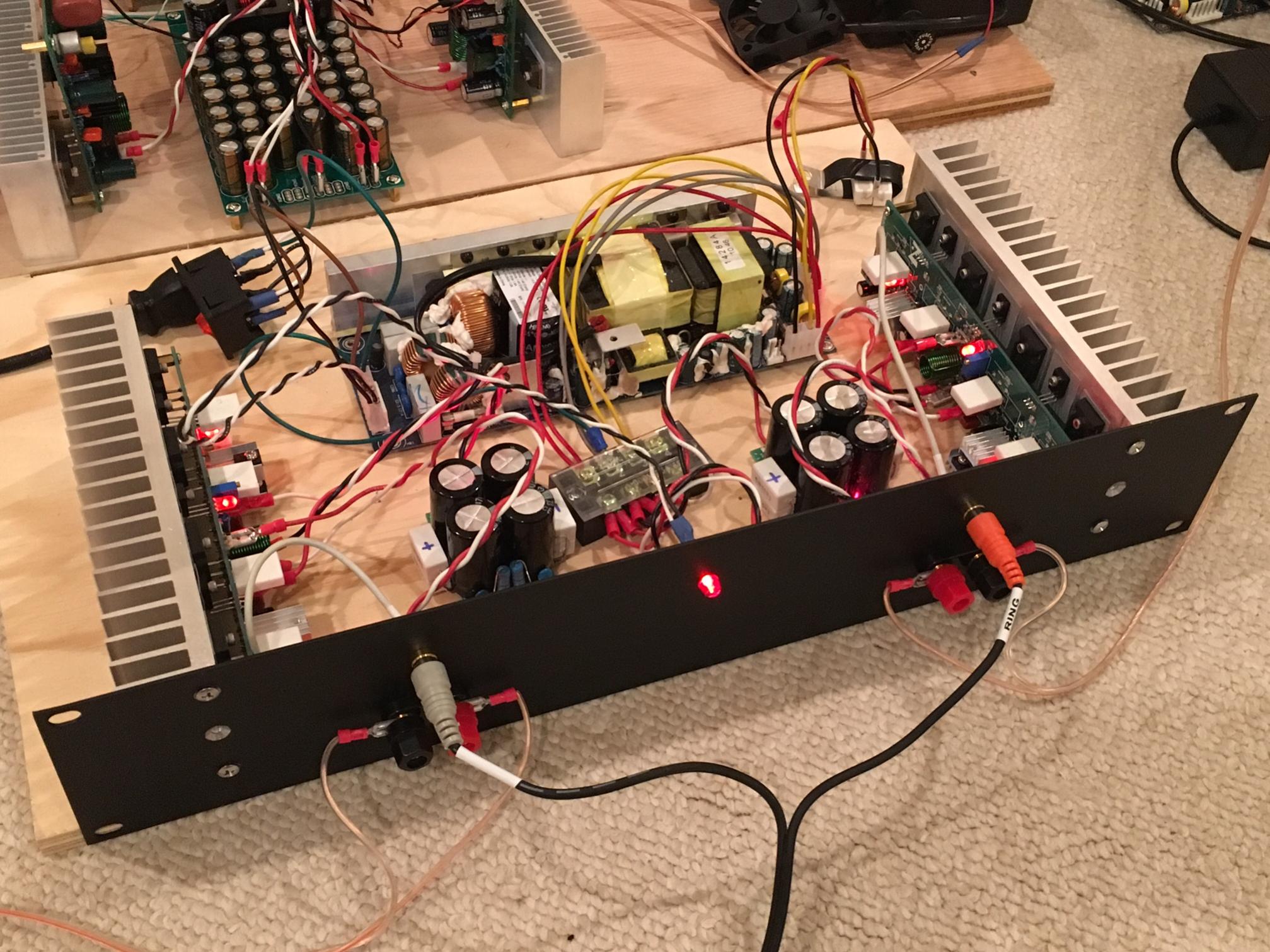
- Status
- This old topic is closed. If you want to reopen this topic, contact a moderator using the "Report Post" button.
- Home
- Amplifiers
- Solid State
- Dx Blame ST - Builder's thread - post pictures, reviews and comments here please.
